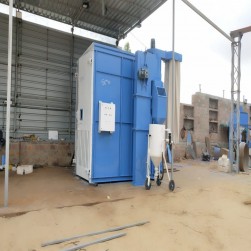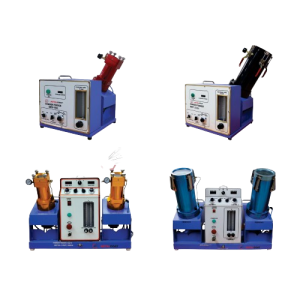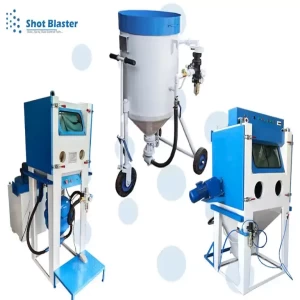Q. What is sand blasting?
Search
All Categories & Products

Blast Room
The blast room is used for blasting purposes, so that all residual dust particles or abrasive media can be trapped in the dust collector and workers can get a cleaner working environment. It also helps protect the environment from harmful unwanted dust particles that are released after the blasting operation. Blast room is made of MS panels because they are easy to assemble.

| MODEL | ASB PJ6-7.5 (Dust collector) |
| Dust collector type | Reverse pulse jet type |
| CFM | 4000 X 1= 4000 |
| No. of filters | 06 |
| Fan motor | 7.5 HP |
| Air duct velocity | 17.8 m/s |
| Air filtration speed | 1.3 m/min |
| Filter cloth area | 60 Sq. Mtr. |
| MODEL | P7- (750 R) Portable sand blasting machine |
| Metal sheet thickness | 6 mm |
| Nozzle size | 8 mm |
| Nozzle material | Tungsten carbide |
| Capacity | 750 kg |
Blast Room
Blast rooms provide operators with a safe, efficient, clean and environmentally friendly working environment during surface treatment or blasting of other machines. It provides protection for operators against harmful sand blasting dust collector. Abrasive media can be recycled and reused, using the blast room during surface preparation. This is one of the safest and most effective methods.
Parts of the Blast Room
|
PART |
CHAMBER |
|
LENGTH |
3500 mm |
|
WIDTH |
3250 mm |
|
HEIGHT |
2750 mm |
|
PART |
METALLIC DOOR |
|
Width |
3050 mm |
|
Height |
2600 mm |
|
Noise level |
70-75 dB |
|
Floor sheet thickness |
4 mm |
|
Vision window |
200 X 200 mm |
A blast room is built by combining different parts. The main parts of the blast room include:
- Dust collector (reverse pulse jet pleating)
- Bucket elevator and media separator
- Portable sandblasting machine P7 (750 R)
- Metal blast room system
- Metal door & Light
- Rubber coating
- Cart and track
- Carry protection
Metallic Blast Room System
The metallic blast room system is also known as the blast room "chamber". It is made from an MS sheet that provides the necessary strength and rigidity to the chamber. The size of the chamber depends on the applications to be carried out within the chamber. The proper design and layout of the structure is done prior to the construction of a chamber. Various panels are designed with MS channel support for better support and rigidity. The entire blasting or surface preparation process takes place inside the chamber.
Rubber Coating
During surface preparation or sand blasting machine, a variety of abrasive media are used. These abrasive media are released into the air during blasting and can cause damage to the blast room and the operator. Rubber liners have been installed on the blast room walls to protect both the blast room walls and the operator. This rubber lining covers every wall in the blast room with a thickness of up to 3mm. Here, strips made by MS are provided with each rubber sheet.
Metallic door
In a blast room, a door is made of sheet metal. The blast room doors are equipped with vision lenses so that the operator can get a proper view to observe the blasting operation inside the blast room. These metal doors have louvers so air can pass through them. In the absence of these grids, a vacuum would be created within the blast chamber that could damage it.
Dust Collector
In the blast room, surface preparation or shot blasting produces a large amount of dust particles that must be separated. These dust mites are very harmful to operators and can cause many illnesses when exposed to them. To remove these dust particles from the blast room, a dust collector system is installed so that unwanted dust can be removed. Various types of dust collectors can be used for this purpose.
The main parts of the dust collector are:
- Blower
- Dust collector system
- Dust removal system
The blower is used to move the dusty air to the dust collector from where they can be separated. Above the blast room, a blower is installed through which all dust particles released after blasting are brought into the dust collector for removal. The dust collector system includes the function of a pleated bag. Dust particles entering the dust collector are trapped in the pleated bag. Blasting is done under high pressure to remove dust from these pleated bags.
In a dust removal system, all dust particles are removed from the dust collector. A sudden shock generated by high pressure air in a pleated bag causes an expansion wave. Folding the bag breaks up the powder cake on top of the pleated bag. And all the dust particles are collected in a tank from which they are separated.
Reverse Pulse Jet Pleated Bag Dust Collector
Reverse Pulse Jet Pleated Dust Collectors use pleated bags to remove dust particles from where they are separated from the blast room. All the dust particles from the blast room enter the dust collector. From where they get stuck in the pleated bag of the reverse pulse jet dust collector. When assembled, they provide a completely dust and pollution free working environment. It consists of six folded filters, each of which is connected to a solenoid valve. The solenoid has a sequential timing controller that controls the operation of the solenoid valve. The solenoid valve works on the pneumatic principle. Power wires are connected to the solenoid valve and when air enters one end of the solenoid, a timer is set for 10 seconds, after which air from the cylinder enters the dust collector and is stored in an SS tank. from where it is removed.
In reverse pulse jet pleated bag dust collector, the dust particles trapped in the pleated bag are exposed to high pressure due to blasting. This high pressure generates a sudden jolt that causes the ripples in the pleated bag to expand. As a result, the powder cake breaks down and accumulates in a tank. It should be ensured that the wave generated by the compressed air travels throughout the pleated bag in order to prevent the dust cake from being properly vented so that all dust particles can be removed.
Reverse Pulse Jet Pleated Bag Dust Collector Features:
- Easy to operate and handle.
- Easy to remove pleated bags
- The installation process is simple.
- Requires low air consumption.
- High filtering efficiency
Reverse Pulse Jet Pleated Bag Dust Collector Application
- Shot Blasting / Shot Blasting Machine
- Powder Painting Booth
- Quarters of a Pint
- Metallic Paint Booth
- Metals and Minerals
Bucket Elevator and Media Separator
When the blasting operation is carried out in the blasting room, residual dust particles and abrasive media may be suspended in the air or some of them may fall to the ground. They need to be separated from the blast room. For this dust collector is used to remove them. A bucket elevator is used to transfer these particles from the blast room to the dust collector. Bucket elevators help to lift these dust particles with the help of conveyor belts. With the help of a conveyor belt, the dust particles and abrasive media are reduced by gravity and then passed to the media separator through the action of the motor. From the bucket elevator, the abrasive media and dust particles are transferred to the media separator.
Media separation helps to separate the abrasive media from the heavy dust particles. After separating the abrasive media from the dust particles, the media separator transfers the abrasive media to the P7 (750R) portable sand blasting machine. In this way, the medium can be reused in a portable sandblasting machine for other processes to be performed on the machine.
Blast Room P7 (750 R)
In a blast room system, a portable blast machine is positioned outside the blast chamber to facilitate blasting using manual blast hoses. It must have a tungsten carbide jet nozzle. A portable sandblasting machine is easy to move from place to place as it has wheels with which it can be easily transported to any job site. It is used to remove dust and rust from the metal surface and provides a smooth surface finish. The selection of abrasive on the portable sandblasting machine should be made according to the application.
For example; If the abrasive medium particle is harder than the metal surface, it may damage the surface and scratch it; Therefore, soft abrasive media should be used for this type of surface. The compressed air together with the abrasive medium from the compressor is expelled at high pressure and speed through a jet hose over the metal surface and all contaminants are removed.
The P7 (750 R) is a remote controlled portable sand blasting machine. Therefore, the machine can be operated by remote control easily. The machine is provided with a remote control lever at the end of the nozzle by means of which ON / OFF operations can be performed easily and automatically. A dead handle is placed on the remote control system. When the deadman handle is activated, the blasting operation is performed and when deadman handle is released, the blasting operation is stopped. The blast hose of the portable blast machine enters through the door into the blast room chamber.
Parts of the Blast Room P7 (750R)
- Pressure cooker
- Tight mesh
- Mushroom valve
- Scape valve
- Pinch valve
- Mix tube assembly
- Jet hose
- Remote control valve
- Jet nozzle
- Air filter
- Nipidman
- Remote control system
Applications of Portable Sand Blasting Machine
- Blasting
- Preparation of the surface before welding or applying any other coating.
- Surface preparation
- Removal of anti-corrosion coating
- Removal of foreign particles from the metal surface
Portable sand blasting machines are mainly used to remove rust and dust on steel pipes, bridges, transformers, large tanks, vehicle bodies, turbines, windmills, railroad cars, military, and shipyards.
Illumination
In a blast room system, when the blasting operation takes place, residual dust particles and abrasive media are released into the air and give the operator inadequate visibility. Lighting has been provided in the blast chamber to provide adequate operator visibility. Wire mesh protected against light lies in the blast room. The intensity of the light inside the blast room should be between 300-400 LUX for better vision.
Control Panel
On a control panel, the phase indicator indicates the phase and the push button is used for on / off operation. The ammeter and voltmeter are used to measure current and volt. Emergency switches help to stop the entire system in an emergency with a single switch. A sequential timer is connected to control the solenoid valve on the dust collector.
A control panel of a blast room system contains all the operational controls. Like:
- Phase indicator (R / Y / B)
- Push button (R / G)
- Ammeter / Voltmeter
- emergency switch
- Double starter
- Sequential timer
Trolley and Track
In a blast room system, the workpiece, metal surface or any job to be shot blasting is brought into the chamber with the help of a provided cart. The workpiece can be heavy and oversized. It will be difficult for the workers to bring them to the chamber. Proper rail and rail arrangements have been made to avoid any damage before and after the blast. Therefore, a carriage and rail system is used to move the workpiece before and after the blasting operation is carried out within the blast chamber to avoid any damage.
Safety Wears
Blasting safety wear an important role in any industry. To protect them from any physical damage, the operator must take adequate safety precautions. Every operator must wear safety clothing while performing any operation in any industry. In a blast room system, during any operation, a large amount of dust collector and abrasive media are released into the air which can affect the operator in a harmful manner. Operators must be fully equipped with protective clothing prior to carrying out blasting or any other operation within the blast room.
They must have a sufficient amount of fresh, filtered breathable air so that they can easily survive the working conditions. This will help them to achieve a comfortable working environment.
An appropriate set of safety clothing should include:
- Air-fed Abrasive Blast Helmet
- Hose hose from machine to operator
- Helmet Air Conditioning
- Hand gloves
- Wellington
- Respirator
- Operator Protection Suite
Blast Room Supplier in India
The blast room should be designed in such a way as to provide efficient abrasive recovery and dust collector system. Dustless Blasting Machine Manufacturing Company is focused on providing best Blast Room system at affordable prices. Our Blast Room is equipped with the finest Chamber, Dust Collector, Steel Shot, Steel Sand, Shot Blast Room System, Aluminum Oxide, Portable Shot Blasting Machine, Sand Blasting Machine, Grit Blasting Machine, Shot Blasting Machine and Bucket Lift.
Blast Room Price in India
Dustless blasting machine is offering blasting machines and products at a low price. Blast Room with or without remote control is available here at very low price. Along with this sand blasting machine, glass beads, steel grit, grit blasting machine, plastic abrasive media, axial flow fan, air breather, grit blasting machine, aluminum oxide, blast room system and dust collectors are also available at affordable prices.
Contact us today for latest Blast Room Price in India.
Ans.
Sand blasting is the activity of coercively impelling a surge of abrasive material against a surface constrained to smooth an unpleasant surface, roughen a smooth surface and shape a surface, or eliminate the surface pollutants. Sand used to be the most usually utilized material, however since the lung infection silicosis is brought about by broadened inward breath of the residue made by sand, different materials are currently utilized in their place.
Q. What is difference between shot blasting and sand blasting?
Ans.
Sand blasting and shot blasting both are the cycle which is being used in mechanical surface cleaning. Many industries that utilization metal applies these techniques in everyday rehearses for eliminating consumption, paint, and different movies and setting up the surface for covering. In the two techniques, cast ironwork is additionally impacted to eliminate old paint layers. In any case, the contrasts between the two cycles are just for rule and application types.
Q. Why Sand blasting is done?
Ans.
The main purpose behind sand blasting is to eliminate paint or rust and other surface-toxins from hardware, vehicles, houses, and practically some other surface. In the interim, it is a surface treatment measure broadly utilized in a wide range of enterprises for different purposes.
Q. What is the use of Sand blasting?
Ans.
To remove paint or rust from the surface Sand blasting is highly recommend. This cycle is coercively impelling a surge of grating material against a surface constrained to smooth or unpleasant the surface. Sand blasting can prompt the paint to look lopsided when it fixes and bubbles once the task gets wrapped up.
Q. What is a Sandblaster job?
Ans.
The sandblaster works to clean and scrape a surface, regularly metal, of any rust, paint, or other undesirable surface materials. In this innovation, the hose associates with the air tank, and the hopper is loaded up with a grating to guarantee the best outcomes with no obstacles.

